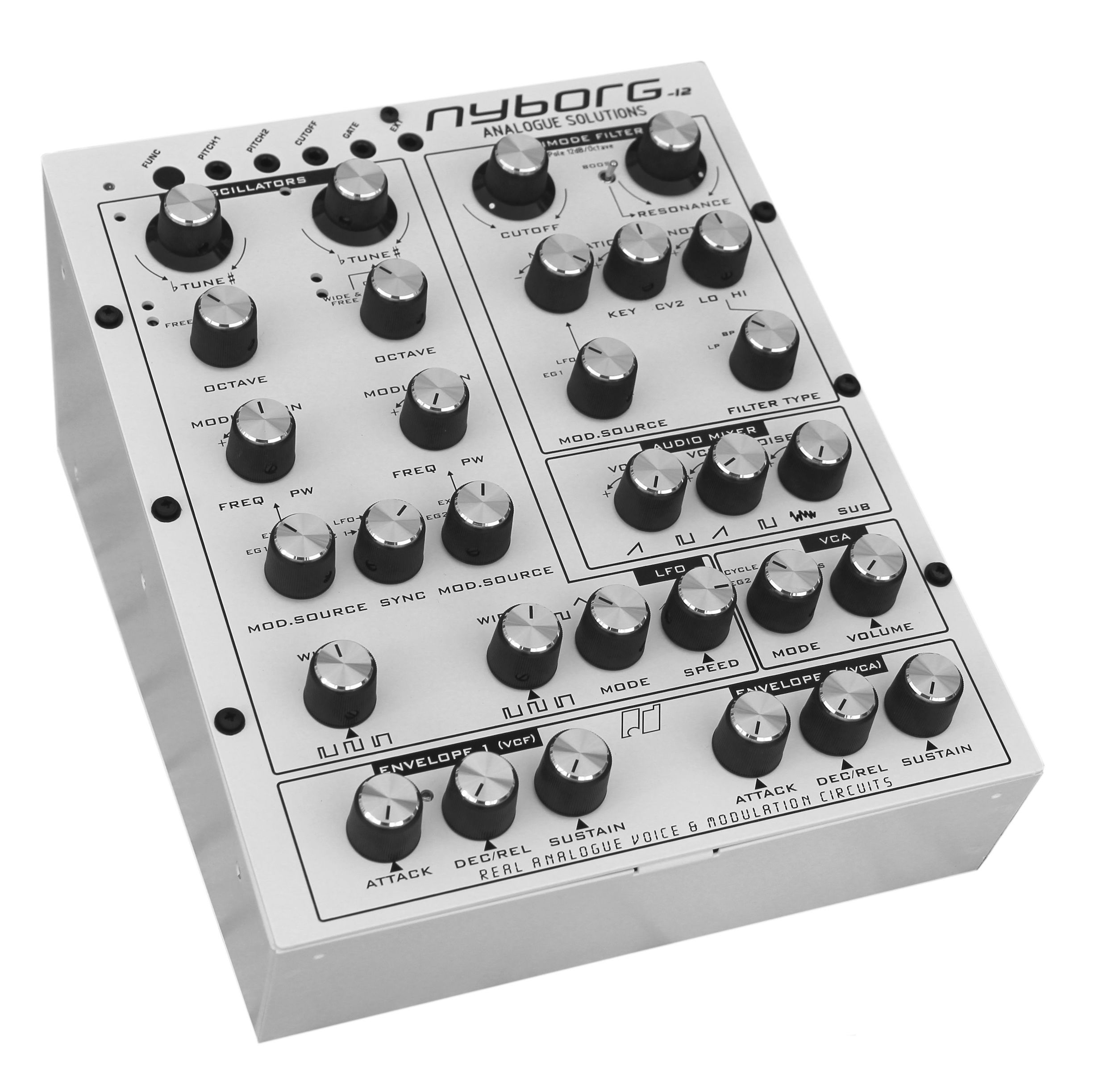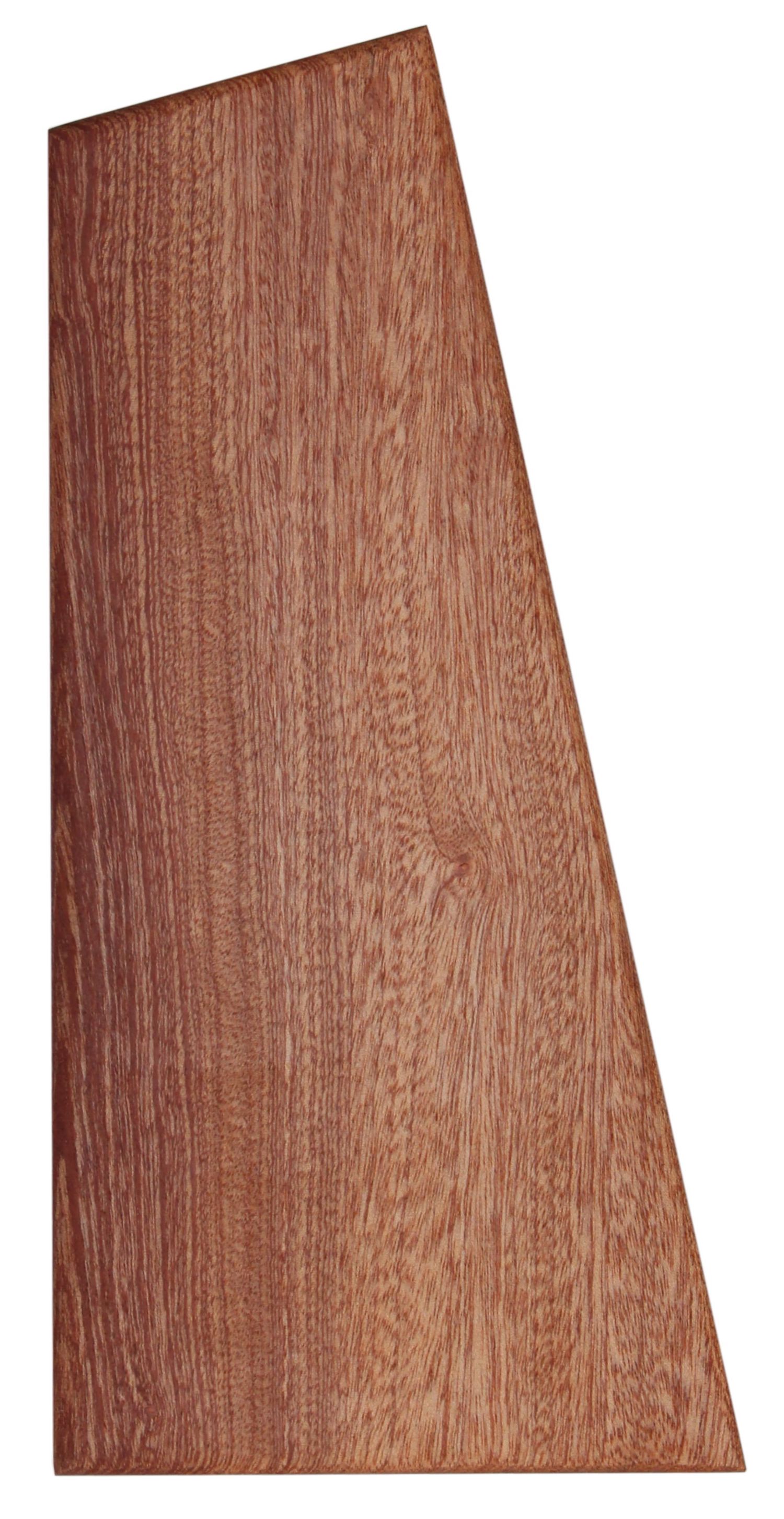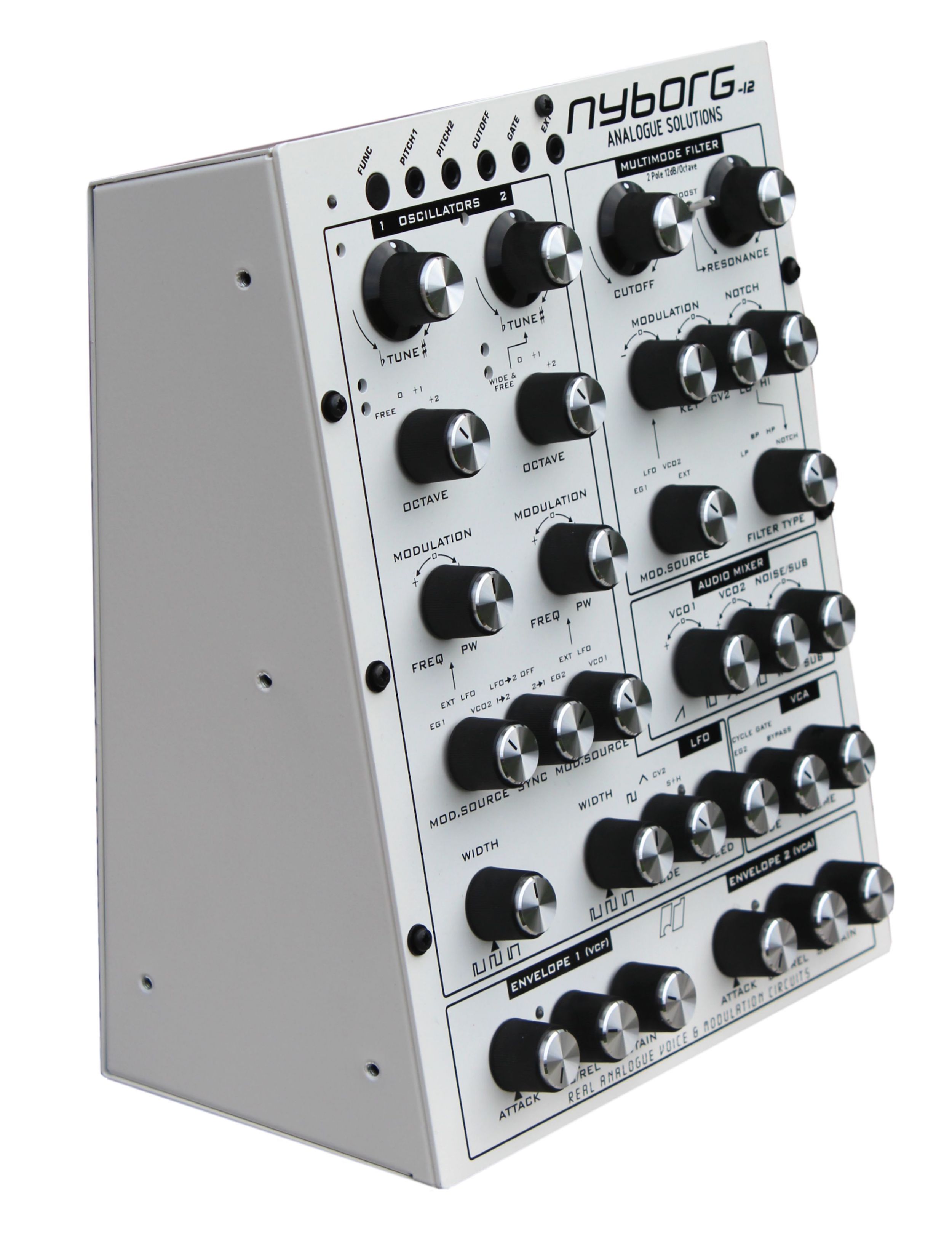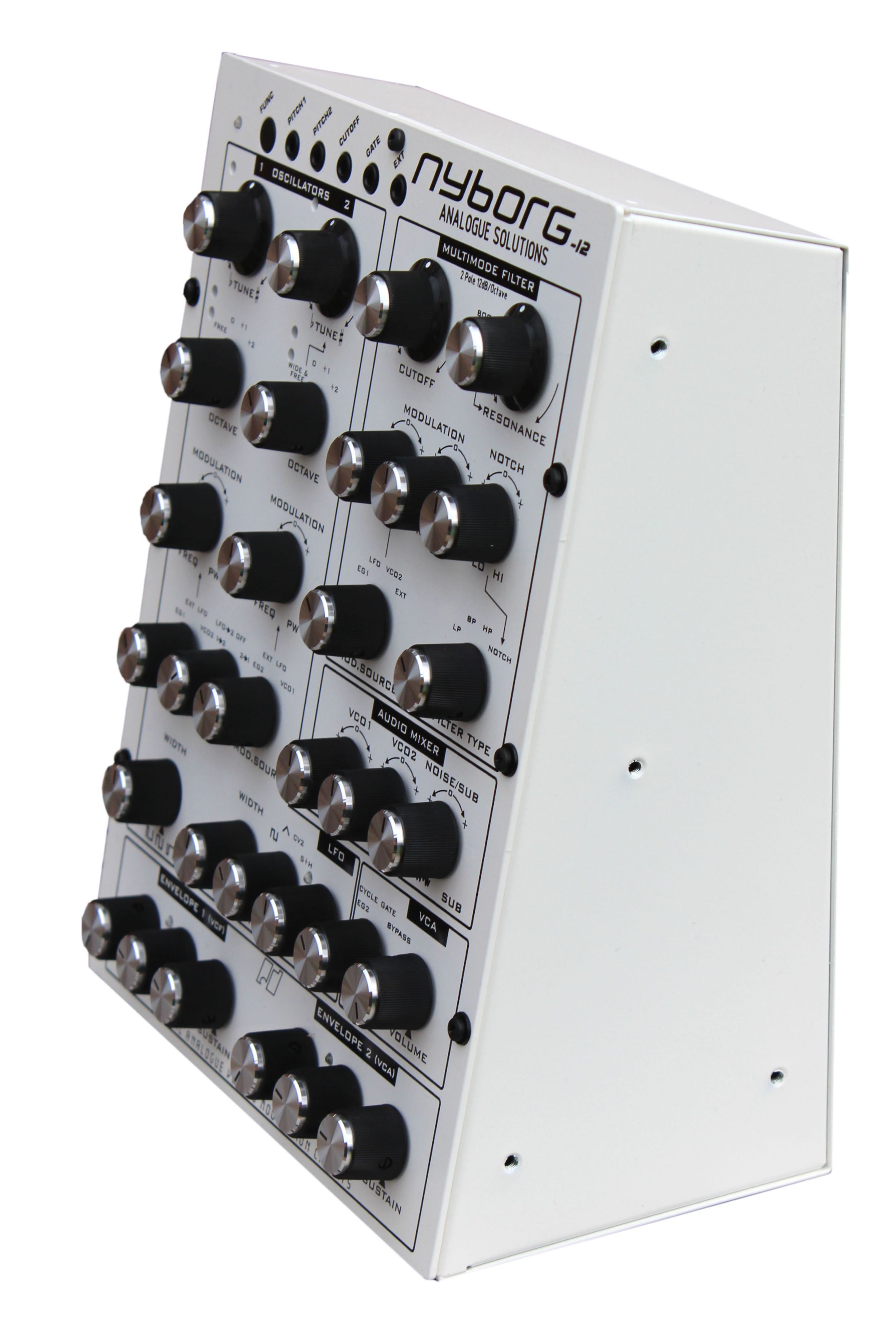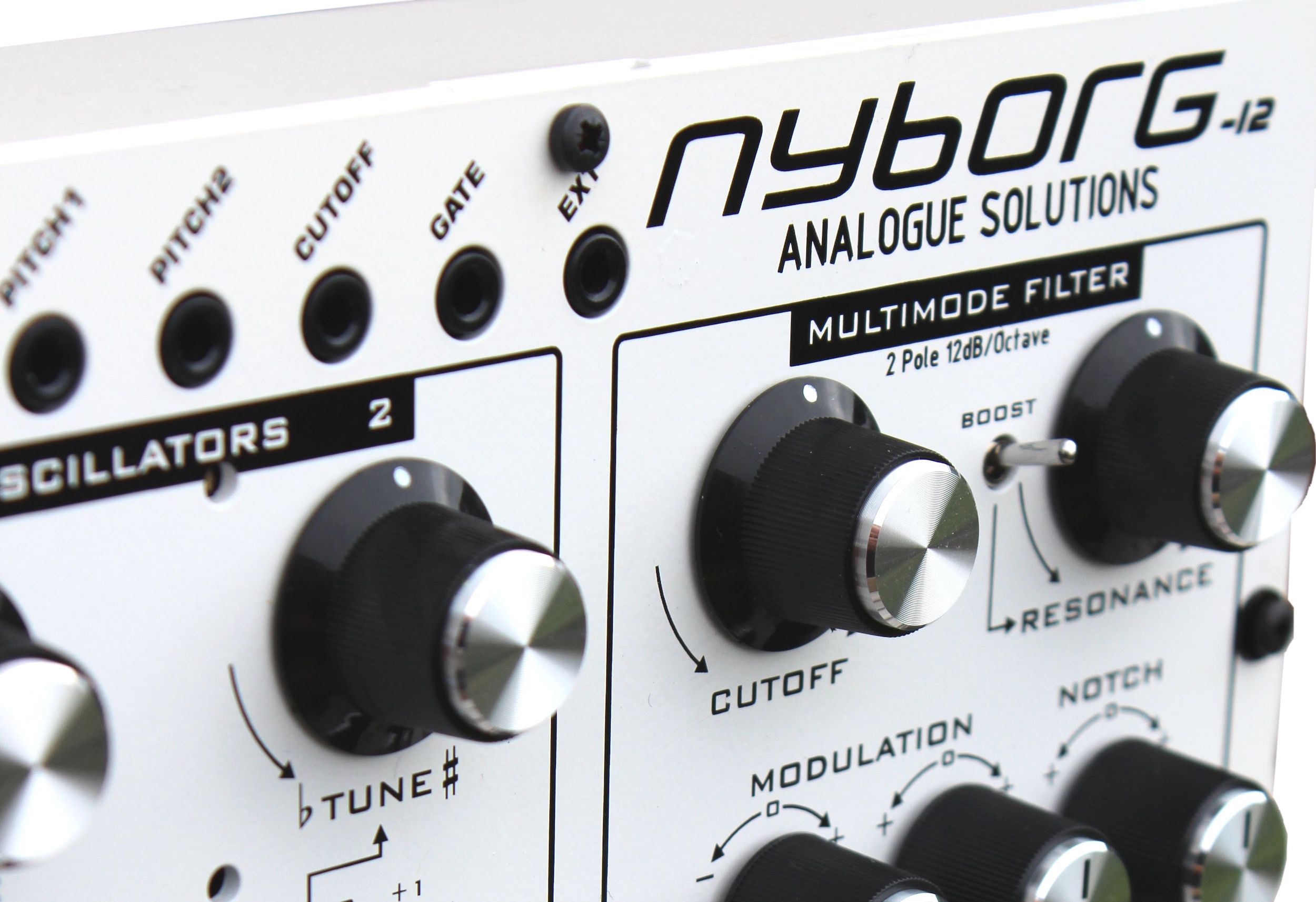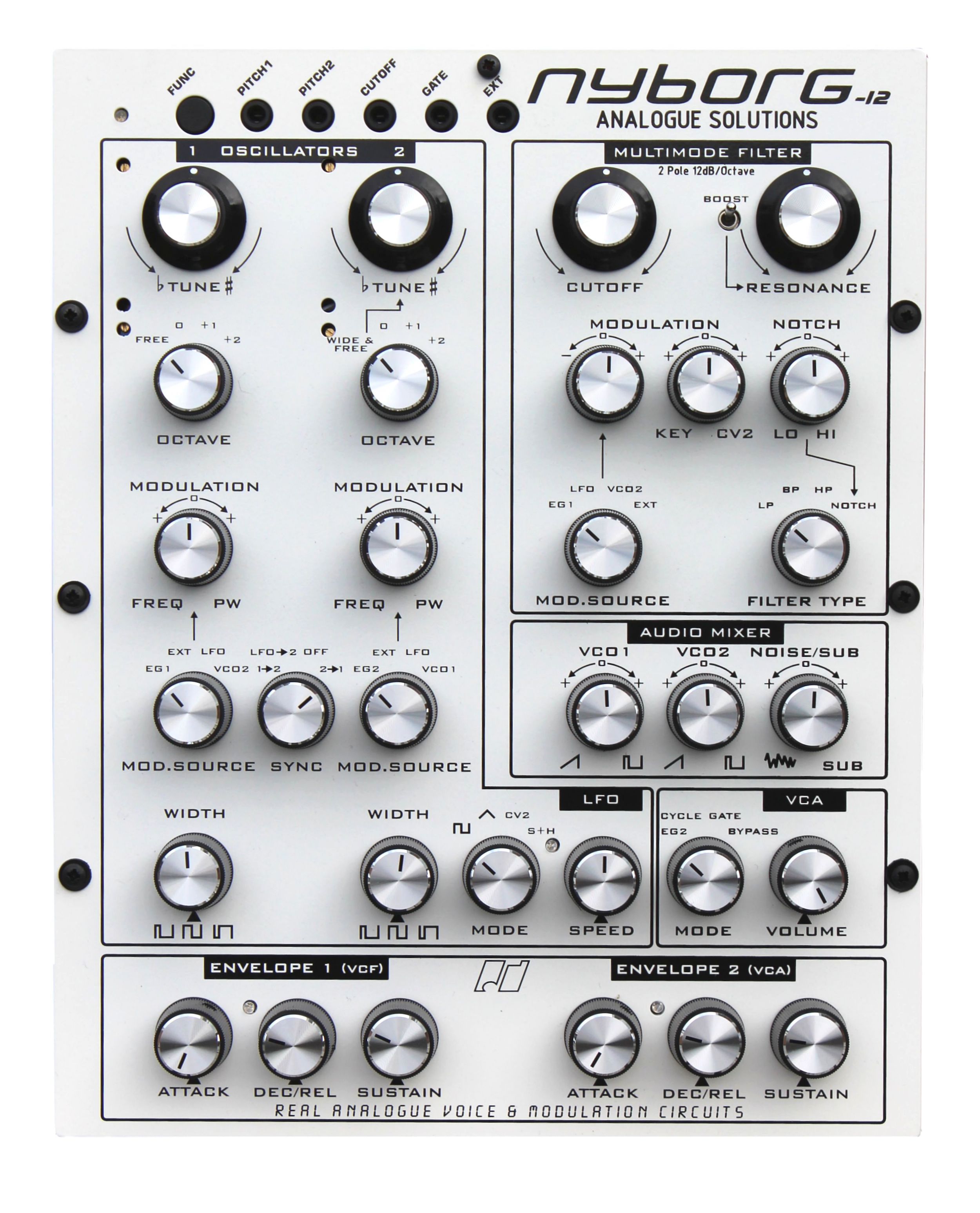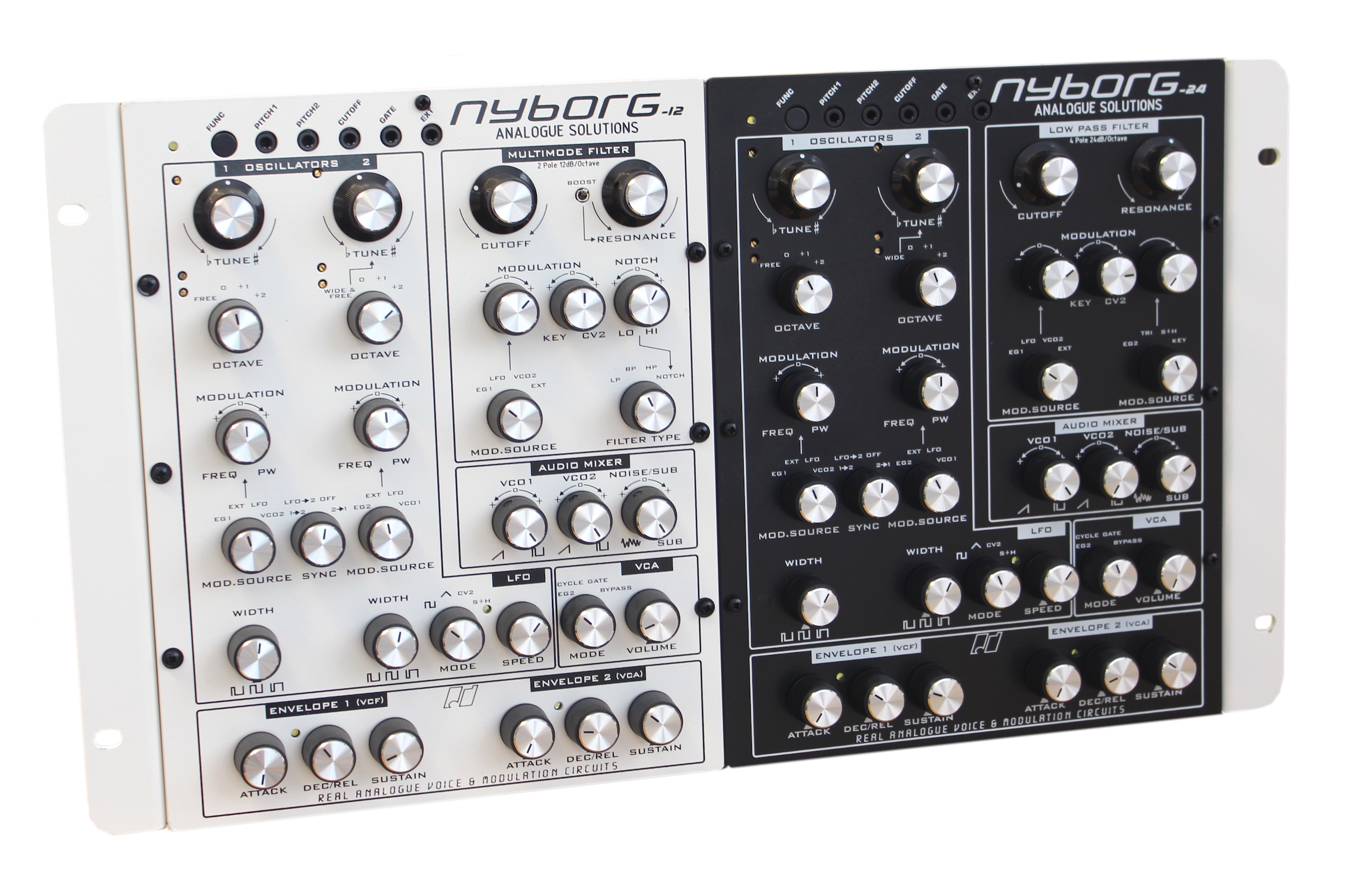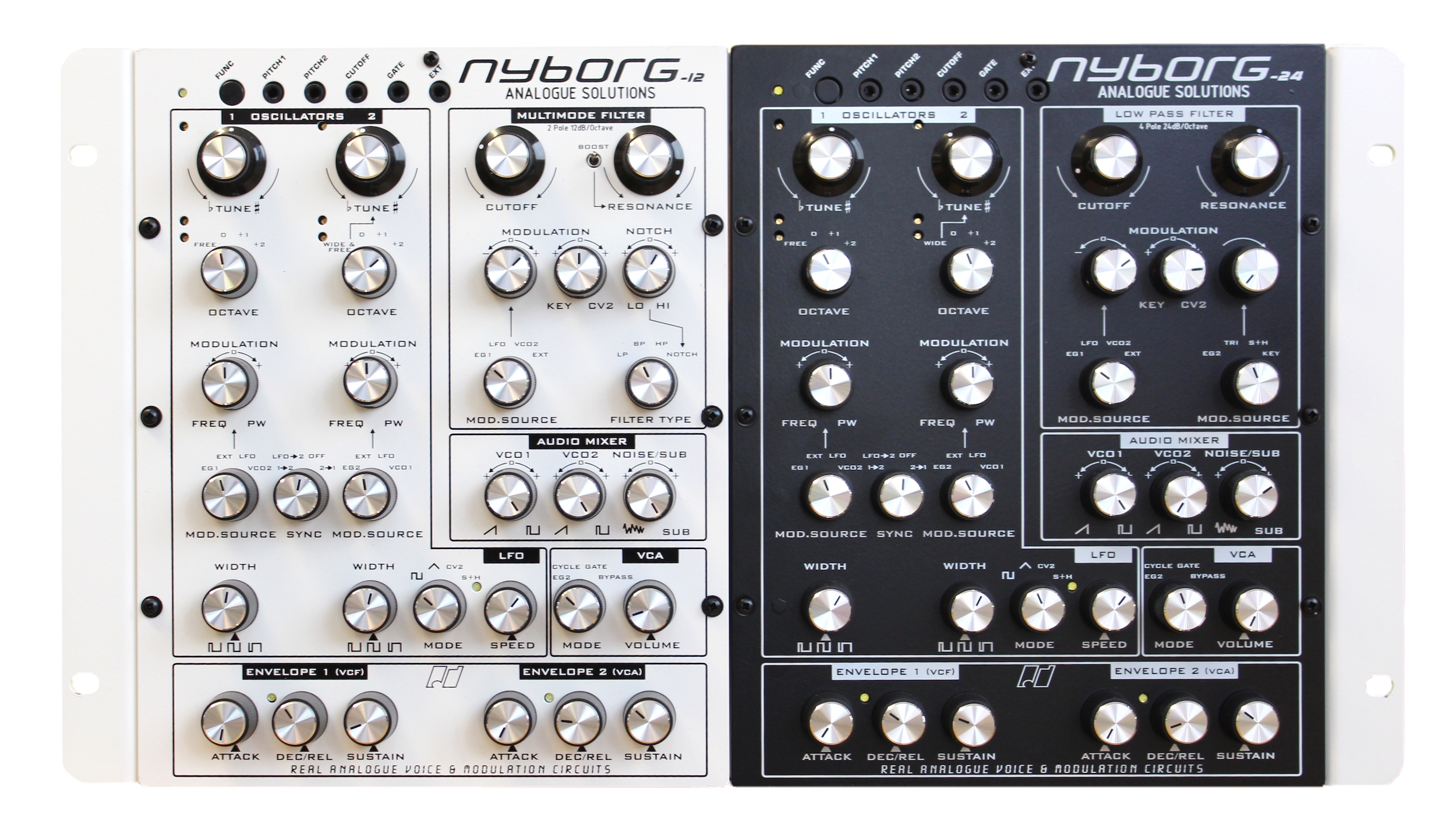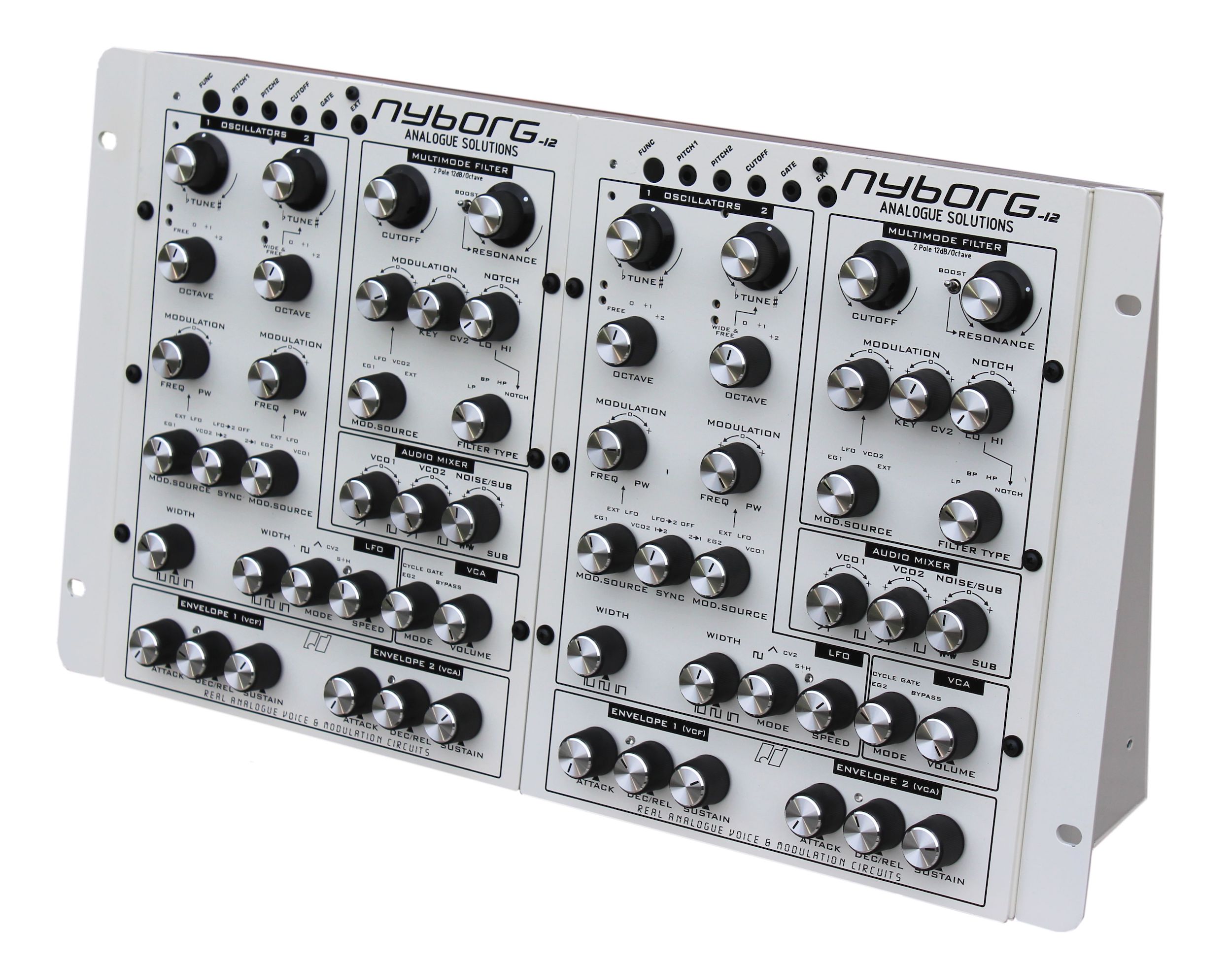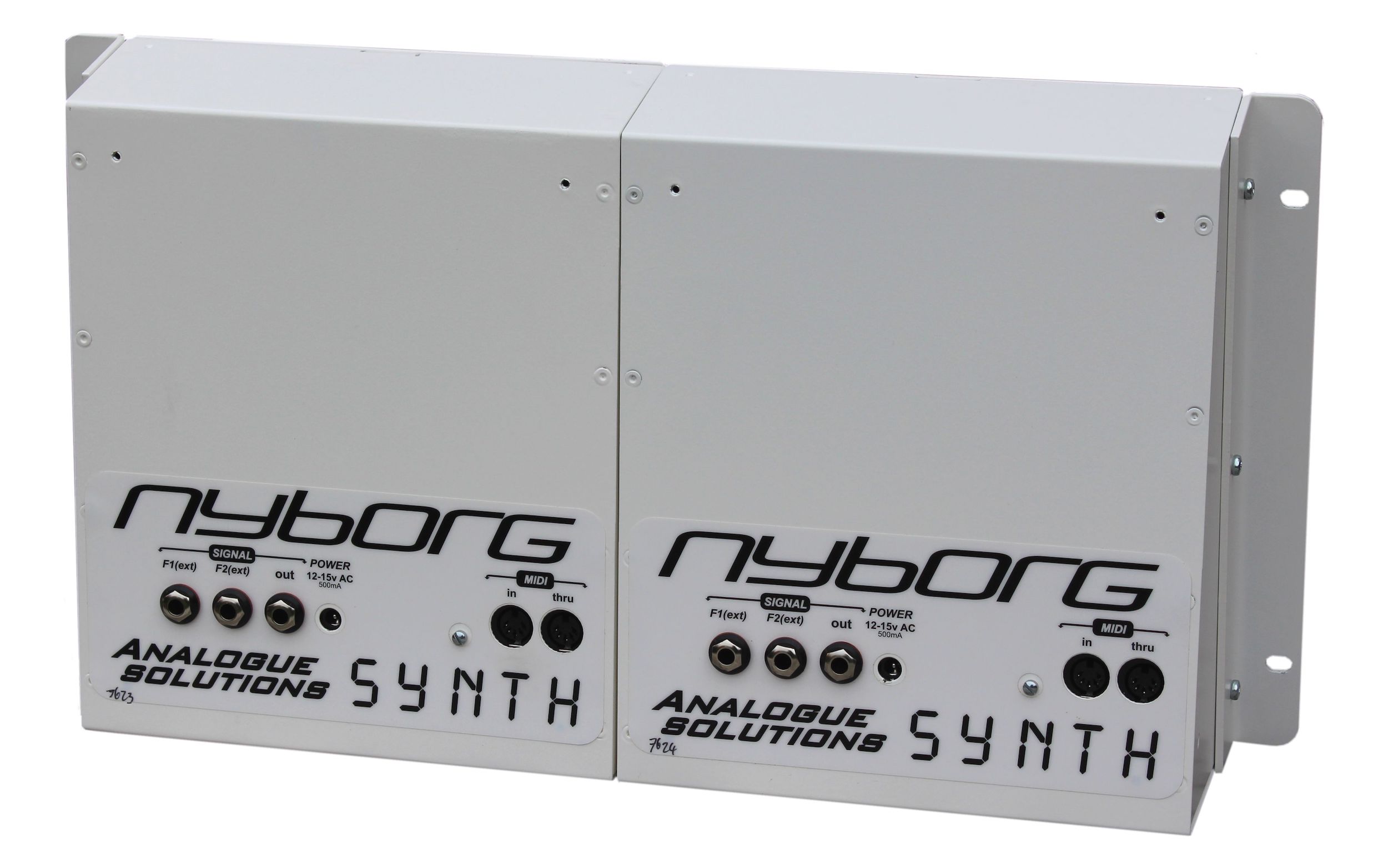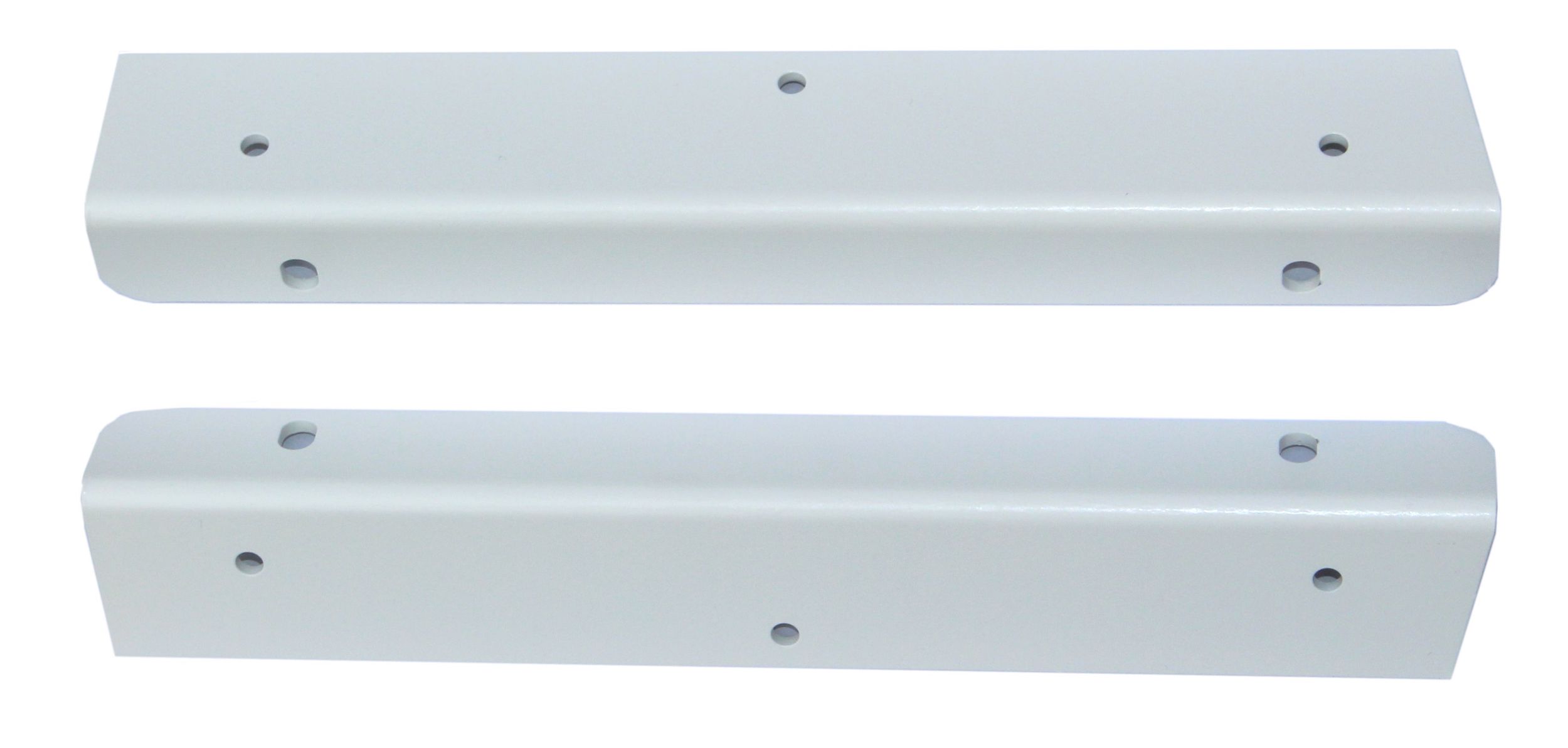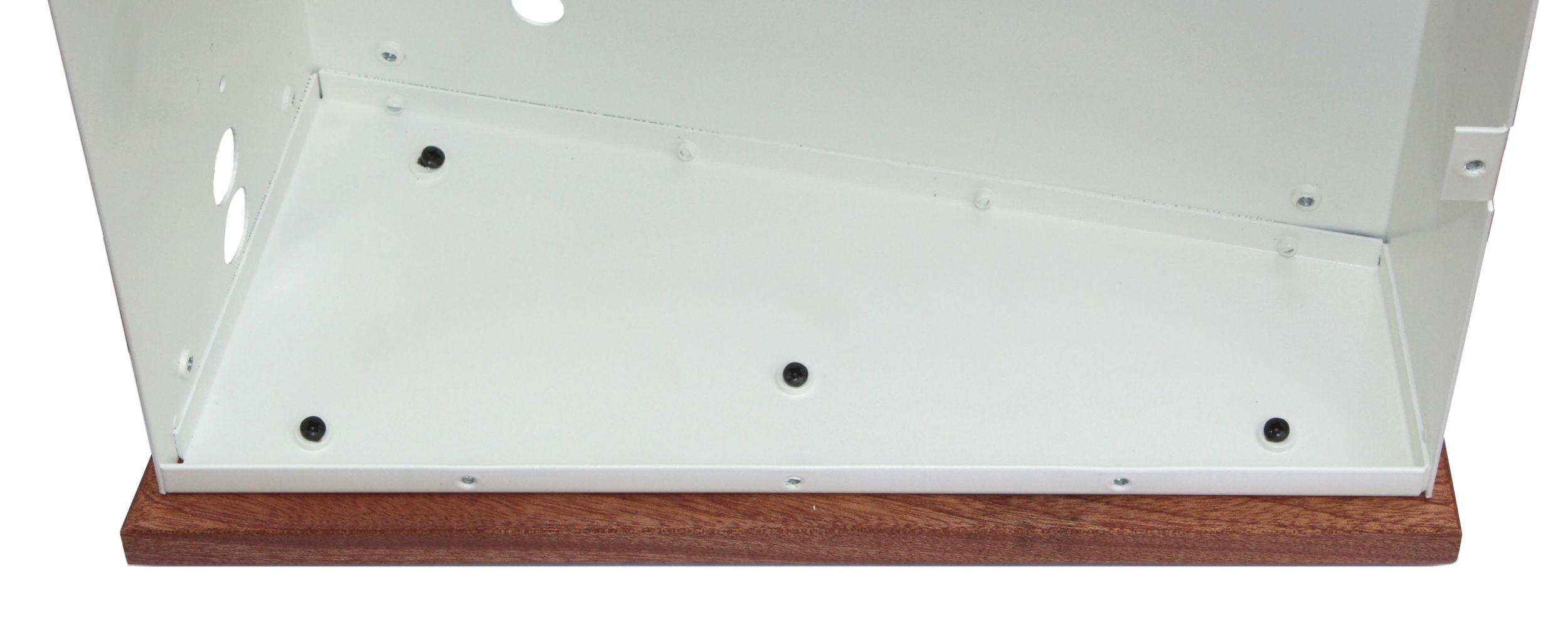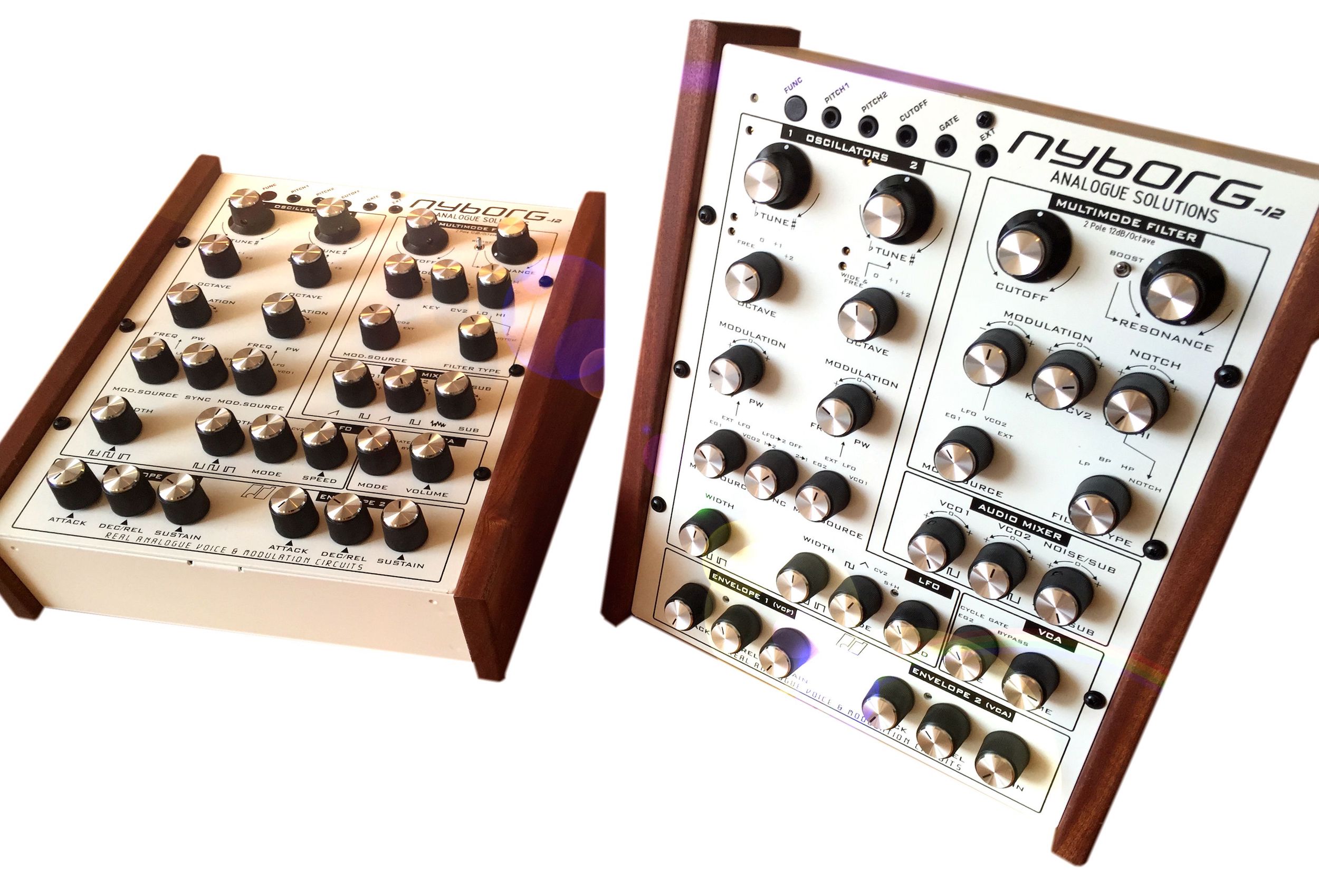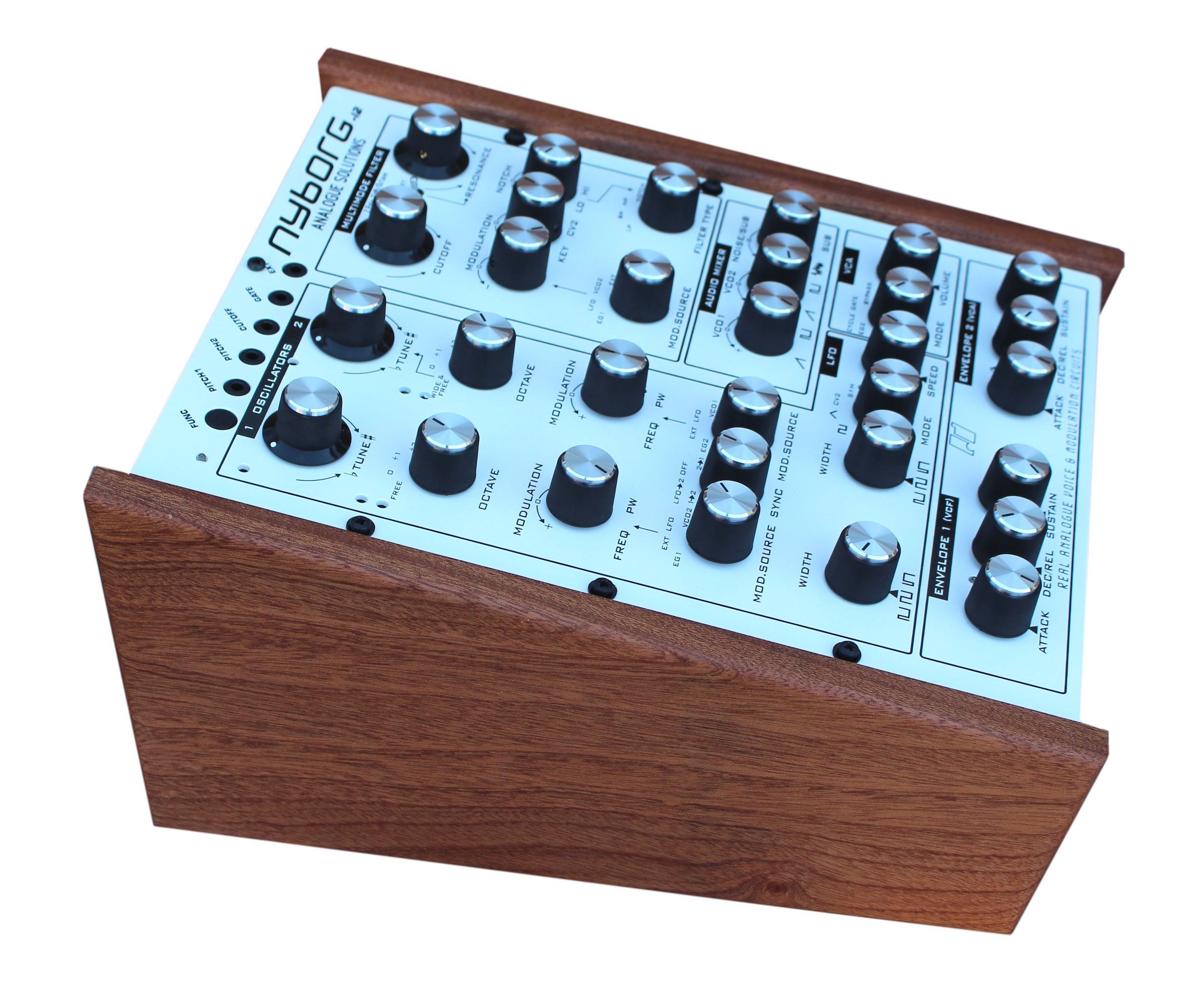Nyborg 12
Nyborg12 Is discontinued.
**** Wood & rack ears are now discontinued ****
Key Nyborg Features
Full rugged steel/aluminium case – no plastic mouldings.
Hand built in Great Britain.
Good quality smooth potentiometers, fully sealed against dust
Good quality knobs with spun aluminium caps
High grade double sided circuit board
High Quality 16bit DAC for MIDI-CV conversion
Very stable MIDI to CV
Very stable analogue oscillators
Hand built by humans
True retro analogue voice and modulation circuits to give an authentic retro sound
Nyborg 12/24 Differences-
12 = has the Telemark synth’s “oberheim SEM” style filter
24= has the Leipzig synth’s “Moog” style filter
All else is essentially identical. Which filter / sound to choose? They are both amazing. Choose either and you will be happy.
Why not buy both? Then rack them side by side with the optional rack kit.
Specification and Modulations Possibilities…FEATURECONTROLSVCO1Tune, Octave, PW Mod, FM Mod, Manual PW, Mod Source, Saw out,
Pulse out, Sync, Free RunVCO2Tune, Octave, PW Mod, FM Mod, Manual PW, Mod Source, Saw out,
Pulse out, Sync, Wide RangeVCFLow pass filter, High pass filter, Band pass filter, Notch
filter, Variable Notch filter. Cut-off, Resonance,
Modulation Amount, Mod Source, MIDI Mod, Resonance BoostEG1ASR envelope with trigger LEDEG2ASR envelope with trigger LEDLFOSpeed, Output Mode (Square, Triangle, Velocity CV, S+H)NOISE GENERATORWhite noiseSUB OSCMinus one octave, taken from VCO1SAMPLE & HOLDFor random modulation effectsMIDI TO CV CONVERTER16 bit high resolution with auxiliary controller CV2 outputRotary controls, Rotary switches
and Push buttonsLEDsJack socketsMIDI Sockets229143x 6.35mm, 5x 3.5mm2DIMENSIONS(W x D x H)WEIGHTX KgPOWERExternal AC mains supplyACCESORIESMains adaptorMIDIIn, ThruAUDIO / CV CONNECTIONSAudio Out, Ext1 (CV or Audio), Ext2 (CV
or Audio), AC power in, MIDI IN, MIDI THRU
Why Do I need this synth? What’s So Special?
Nyborg is a compact true analogue mono synth in a neat, smart, small package.
When we say ‘real analogue’ we mean that the entire audio patch and all modulation is entirely analogue, using circuits based on awesome sounding vintage 1970s designs. There circuits are not locked down by CPUs, controls are quantised and read by CPUs. With exception of the MIDI to CV circuit, which by its nature must have a digital element, Nyborg really is analogue and the sound benefit is immediately apparent!
We get may good comments about how good Analogue Solutions sound, how good, warm and full of character they are.
The synth has been designed by a musician who is a big fan of electronic music, and knows how to program a synth, not designed by an engineer. So, the modulation choices and range of sounds they produced have all been carefully thought out and quickly give you those sounds you want: huge bass, synth leads, percussion, effects, modular style sounds.
What are the Differences Between Nyborg-12 and Telemark?
They essentially share the same circuits, so will sound similar. The main differences are outlined below:
Nyborg12 Advantages / Additions
Octave switches on the VCO.
‘Free run’ setting – disconnects VCO from MIDI pitch. Good for effects or using the VCO as a modulator.
Wide setting – allowing the VCO Tune knob to have a super wide range – good for when the VCO is used as a modulator.
Q Boost on the filter – to make resonance go insane.
VCO Sub Osc is hard wired to the Mixer – for super convenience.
Much smaller than Telemark – for those with limited space.
Lower price point.
Two Nyborgs can be racked side by side using the optional rack kit,
Telemark Advantages / Additions
Plenty of signal patch points! Telemark can be more fully integrated into an existing modular system. Cross patching between the two is possible.
The patch points enable additional modulation, effects and sounds that cannot be done with the switches alone.
Ring Modulation.
The Sub Osc is not hard wired. This means it can be patched up in other ways, like a clock divider, or to half the rate of the LFO square wave.
So in summary – which to choose?
Main points are
Size
Cost
Do you want the advantages the extra sockets give?
There are points personal to your situation!
If price and size are not an issue – then
Nyborg – the fact it has Sub Osc hard wired allows a wider range of sounds to be made without patching.
Telemark – it will do far more, but requires the work of patching.
So the summary here is Telemark will do much more than Nyborg but requires the extra effort (some patching). Nyborg will do more than an un-patched Telemark.
NYBORG: SYNTH – PERCUSSION – AUDIO PROCESSOR
Nyborg is a compact analogue synthesizer. Analogue – as in really analogue. Aside from the MIDI chip (which has to be digital), everything else is totally analogue using real transistors and op-amps. There are no CPU stabilised and quantised circuits, no DCOs, no digital LFOs and no digital EGs, as found on other so called analogue synths. The circuitry is based on designs dating back to the mid-1970s. So Nyborg has a genuine old sound.
Audio Applications
MONO SYNTHESISER
Nyborg is for use any time you need analogue sound effects, fat basses, screaming leads, beeps, tones, zaps, and all the other crazy sounds associated with analogue synthesis. Use in place of your boring digital synths and DSP soft synths.
EFFECTS PROCESSOR
Nyborg has an audio input socket, so you can feed external sounds through the on-board analogue filters for analogue processing.
DRUM SYNTHESISER
Nyborg is able to produce electronic percussion – kick, snare, hihats, cymbal, etc.
MODULAR SYNTHESISER
Nyborg is pre-patched – but has such a wide range of modulation routing possibilities that it is almost as versatile as a modular and can produce the same types of sounds, without the mess and confusion of cables. It has some patch sockets that enable you to connect it to an external modular.
MIDI (DAW Use) or CV & Gate?
This unit can be used with a MIDI keyboard (or DAW, or sequencer) or you can use it with an analogue sequencer, such as Oberkorn.
It can also be used by MIDI and CV at the same time! So you could have an analogue step sequencer such as Oberkorn playing a little melody, then using a MIDI keyboard (or MIDI sequencer) transpose the Oberkorn sequence.
Circuits Included
Oscillators
There are two VCOs – each providing a wealth of features and modulation choices.
Controls include: TUNE, OCTAVE, MODULATION depth and destination, MOD. SOURCE (EGs, VCO audio, External CV, LFO), manual pulse WIDTH, VCO Sync
Low Frequency Oscillator
The LFO has triangle and Square wave modulation signals. The MODE switch can also be used to route Sample And Hold or CV2 (velocity) signals to the VCF and VCOs.
Filter
Nyborg uses a 2 pole 12bB per octave multimode filter. What does this mean? It uses the same filter as the legendary Telemark synth, which is similar (but not the same, having its own character) to the old Oberheim SEM. The filter is actually four types in one. Low pass, Band pass, High pass and Notch filters.
Controls include: CUTOFF, RESONANCE, MODULATION depth (- and +), MOS.SOURCE (EG, LFO, VCO audio, External CV), KEY voltage, CV2 voltage (velocity), NOTCH high/low, FILTER TYPE (high, low, band, notch).
Mixer
Audio choices are the Saw or Square wave of each VCO, Noise or, for added fatness, Sub-Oscillator.
Amplifier
The VCA can be controlled from Gate or Envelope. It can be set to BYPASS so it is always ‘open’. This allows Nyborg to be used as an effects processor. Finally there is a CYCLE option. This sets the envelope to be constantly re-triggered by the LFO allowing for hands-off sound effects.
Envelopes
There are two EGs – each having control over ATTACK, SUSTAIN, and combined DECAY/RELEASE.
Modulation
Great thought has been placed into modulation route choices, allowing a wide range of sounds to be produced, including percussion and ‘modular’ style sounds.
MIDI
MIDI is intentionally kept simple – so you can concentrate on making new sounds and making music – not getting tied up with SYSEX programming.
You get the all important control over filter cut-off using MIDI Velocity (or a MIDI controller).
External CV Control Sockets
Nyborg can be controlled via an external analogue sequencer, such as Oberkorn, using the top panel CV sockets.
There are pitch CV sockets for each VCO PITCH1 and PITCH2, filter CUTOFF, GATE (to trigger the EGs), EXT (to feed an external CV to various circuits).
Also, on the rear panel are two spare 6.35mm big jack sockets. Using these you can route external audio through the filter. Set the VCA to BYPASS and use Nyborg as an effects processor!
Mounting Options
Nyborg can be orientated and configured in several ways;
VERTICAL (TALL)
As standard, it comes as a vertical desktop unit just like it’s big brother Telemark.
HORIZONTAL (FLAT)
It is possible to reconfigure it so that it is a flat table top unit, like its cousin Leipzig-S is. This requires some minor screwdriver work.
TWO (OR MORE!) SIDE BY SIDE
Two (or more!) units can be bolted side by side. And of course you can also fit the optional wood sides to these, or, reconfigure them to be horizontal flat units.
TWO UNITS RACKED
Two units can be bolted together (like above) and then you can also fit the optional rack ear brackets, and rack mount the whole assembly.
**Note: Wood side panels are discontinued.


